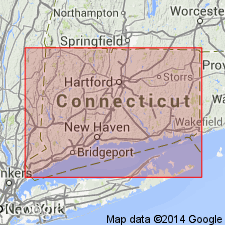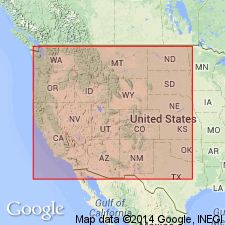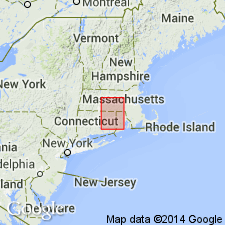
- Usage in publication:
-
- Putnam gneiss
- Modifications:
-
- Named
- Dominant lithology:
-
- Gneiss
- Schist
- Quartzite
- AAPG geologic province:
-
- New England province
Summary:
Named Putnam gneiss for town of Putnam, Windham Co., CT. Consists of bands of schist, gneiss, quartzite, and igneous intrusions in great variety. In texture it varies from compact bluish-black slate and quartzite through fine black schist to coarse gray quartzose schist and feldspathic gneiss. Includes beds of limestone, intrusive sheets of Sterling granite gneiss and pegmatite, amphibolite, and layers of black granite porphyry. In composition it shows gradations from hornblende-biotite schist (or sedimentary amphibolite?) with little or no feldspar, through quartz-biotite schist and gneiss to quartzite. Evidence indicates that the Putnam gneiss underlies the Scotland schist. The two formations are conformable and pass into each other without noticeable change. Of sedimentary origin. Age is considered to be Late Carboniferous or post-Carboniferous.
Source: GNU records (USGS DDS-6; Reston GNULEX).

- Usage in publication:
-
- Putnam Group*
- Modifications:
-
- Geochronologic dating
- AAPG geologic province:
-
- New England province
Summary:
Pg. 16, geologic time scale (inside front cover). Putnam Group. Schist, gneiss, and pegmatite samples from Tatnic Hill Formation, and sillimanite-pinite schist, biotite gneiss, and graphite schist phases, in Norwich and Canterbury Plainfield quadrangles, New London and Windham Counties, Connecticut, yielded Pb-alpha ages from 535 +/-60 Ma to 280 +/-30 Ma; reconnaissance ages. Ages published by Snyder (1964); recalculated using decay constants of Steiger and Jager, 1977 (Earth Planet. Sci. Letters, v. 36, p. 359-362). [See also entry under Tatnic Hill.]
Source: Publication.

- Usage in publication:
-
- Putnam Group
- Modifications:
-
- Not used
- AAPG geologic province:
-
- New England province
Summary:
Putnam Group designation not used for Quinebaug and Tatnic Hill Formations.
Source: GNU records (USGS DDS-6; Reston GNULEX).

- Usage in publication:
-
- Putnam Group*
- Modifications:
-
- Age modified
- AAPG geologic province:
-
- New England province
Summary:
Age of the Putnam Group, separated from the Brimfield Group by a fault in this area, is considered to be Late Proterozoic(?), based on 730 Ma of the Fishbrook Gneiss in MA and the 440 Ma Hedgehog Hill gneiss intruded into the younger Brimfield Group.
Source: GNU records (USGS DDS-6; Reston GNULEX).
For more information, please contact Nancy Stamm, Geologic Names Committee Secretary.
Asterisk (*) indicates published by U.S. Geological Survey authors.
"No current usage" (†) implies that a name has been abandoned or has fallen into disuse. Former usage and, if known, replacement name given in parentheses ( ).
Slash (/) indicates name conflicts with nomenclatural guidelines (CSN, 1933; ACSN, 1961, 1970; NACSN, 1983, 2005, 2021). May be explained within brackets ([ ]).

